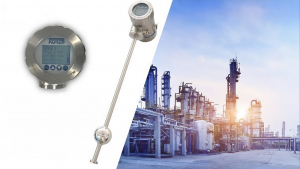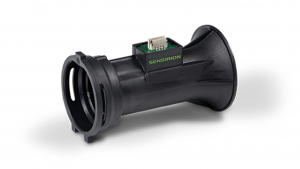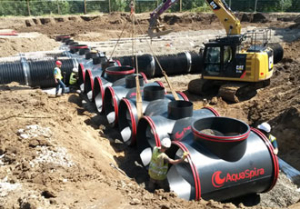Simpler Mounting for Sensors
30th May 2008
Source:
Rencol
The sophisticated systems that are being increasingly used to enhance the safety and comfort of modern vehicles make extensive use of sensors. The key to getting the best from these tiny but critical components is, however, all in the mounting, says Chris Needes, Automotive Product Manager at Saint-Gobain Performance Plastics Rencol.
Sensors in vehicles already play a key role in many of the systems – from air conditioning to anti-lock braking – that today's drivers have come to take almost for granted. And current developments strongly suggest that there will be even more reliance on sensors in the future to underpin vehicle performance and safety.
Perhaps the most important of these developments is the growing interest in Electronic Stability Control (ESC). In the USA, the National Highway Transport Safety Authority (NHTSA) has estimated that the universal adoption of ESC could cut rollover accidents by more than 60% and single-vehicle accidents by more than 30%.
The NHTSA is, therefore, recommending that ESC should be mandatory for all light vehicles sold in the USA after 2009. This move would result in a requirement for 16 million ESC systems per year in the USA alone.
Europe seems less ready to adopt a legislative approach, despite the fact that Bosch and Mercedes Benz in Germany pioneered ESC as long ago as 1995. Nevertheless, the European demand for ESC is increasing and it will be given a further boost if, as has been suggested, the respected car-testing organisation EuroNCAP starts to take ESC into account in its vehicle safety ratings.
But what exactly is ESC? In outline it is a system that in addition to ensuring braking stability and controlling wheelspin as a conventional anti-lock braking system would, also modulates the braking on individual wheels to prevent the vehicle from spinning out of control. Some of the most advanced systems even partially take over the steering of the vehicle.
There are various ways that these functions can be implemented, but all depend on inputs from a whole range of sensors to provide the ESC system with information about, for example, wheel speeds, lateral acceleration, steering position, throttle setting and brake pressure.
It's worth mentioning that many of the sensors will already be fitted even in vehicles that don't offer ESC, where they are used for example by anti-lock braking systems. Clearly, if the ESC and/or other safety-related systems are to perform their potentially life-saving functions dependably, it is necessary to ensure that the sensors operate correctly and reliably.
This makes it essential to give very careful attention to the way the sensors are mounted. At first sight, sensor mounting may seem a trivial problem, but it's important to bear in mind two key considerations: sensors and the magnets that are frequently used with them are relatively fragile and to operate correctly they must in most cases be positioned very accurately.
A third factor that can never be ignored is cost – given the notorious price sensitivity of automotive manufacturing, the chosen mounting method must add as little as possible to the overall cost of the assembly.
Taking into account these requirements it's not hard to see that the seemingly straightforward approach of using an interference fit to retain the sensor or magnet in position over a shaft or in a cavity is unlikely to be satisfactory. While it is certainly an inexpensive mounting method the forces needed to fit the component are very likely to result in damage.
In the worst case such damage may be sufficiently minor to go unnoticed until the vehicle has been in use for some time, when it can lead to premature failure. Should this happen the cost of the replacement sensor may well be small, but the cost of fitting it is likely to be considerable. Plus in-service sensor failures can have serious safety implications.
An alternative sensor mounting method that is less likely to cause mechanical damage is the use of adhesives, unfortunately, this approach brings its own problems.
The first is that it's very difficult to position the sensor accurately when using adhesives. The second, and arguably even more serious problem is that, once the adhesive has cured, reworking the assembly is virtually impossible. This can be an issue both at the manufacturing plant and if a sensor needs to be replaced as the result of an in-service failure. A final potential problem though admittedly rare with modern materials is failure of the adhesive bond.
Fortunately, there is now another option for sensor mounting: the use of tolerance rings. Since these invaluable components are less well known than they deserve, it may be useful to briefly explain what tolerance rings are. Essentially, they are very straightforward – they’re simply radially sprung steel rings that are designed to be press fitted between two mating components. They are, in other words, a special form of frictional fastener.
Typically manufactured from high quality spring steel, stainless steel or specialist spring materials, tolerance rings are invariably custom designed to suit a particular application. All types, however, have one essential characteristic in common – a series of protrusions or ‘waves’ around their circumference. Each of these waves acts as an individual radial spring which, when the tolerance ring is in situ, retains the mating components firmly and in precise alignment with each other.
Tolerance rings are suitable for use with almost any annular or cylindrical sensor or sensor magnet and will allow it to be mounted easily with a minimum of force. Accurate positioning is easily achieved and should reworking ever be necessary it can be carried out simply and with minimal risk of damage to the components involved. Tolerance rings are also inexpensive – typically just a few pennies each when purchased in quantity.
As we have seen, modern vehicles are increasingly reliant on sensors for many of their important functions but the sensors can only give predictable and dependable performance if they are well mounted.
Tolerance rings provide a perfect mounting solution at minimal cost, so there can be little reason not to use them. In fact, neglecting to spend a few pence on tolerance rings in a vehicle selling for thousands of pounds could easily be seen as a classic case of penny wise, pound foolish.
Perhaps the most important of these developments is the growing interest in Electronic Stability Control (ESC). In the USA, the National Highway Transport Safety Authority (NHTSA) has estimated that the universal adoption of ESC could cut rollover accidents by more than 60% and single-vehicle accidents by more than 30%.
The NHTSA is, therefore, recommending that ESC should be mandatory for all light vehicles sold in the USA after 2009. This move would result in a requirement for 16 million ESC systems per year in the USA alone.
Europe seems less ready to adopt a legislative approach, despite the fact that Bosch and Mercedes Benz in Germany pioneered ESC as long ago as 1995. Nevertheless, the European demand for ESC is increasing and it will be given a further boost if, as has been suggested, the respected car-testing organisation EuroNCAP starts to take ESC into account in its vehicle safety ratings.
But what exactly is ESC? In outline it is a system that in addition to ensuring braking stability and controlling wheelspin as a conventional anti-lock braking system would, also modulates the braking on individual wheels to prevent the vehicle from spinning out of control. Some of the most advanced systems even partially take over the steering of the vehicle.
There are various ways that these functions can be implemented, but all depend on inputs from a whole range of sensors to provide the ESC system with information about, for example, wheel speeds, lateral acceleration, steering position, throttle setting and brake pressure.
It's worth mentioning that many of the sensors will already be fitted even in vehicles that don't offer ESC, where they are used for example by anti-lock braking systems. Clearly, if the ESC and/or other safety-related systems are to perform their potentially life-saving functions dependably, it is necessary to ensure that the sensors operate correctly and reliably.
This makes it essential to give very careful attention to the way the sensors are mounted. At first sight, sensor mounting may seem a trivial problem, but it's important to bear in mind two key considerations: sensors and the magnets that are frequently used with them are relatively fragile and to operate correctly they must in most cases be positioned very accurately.
A third factor that can never be ignored is cost – given the notorious price sensitivity of automotive manufacturing, the chosen mounting method must add as little as possible to the overall cost of the assembly.
Taking into account these requirements it's not hard to see that the seemingly straightforward approach of using an interference fit to retain the sensor or magnet in position over a shaft or in a cavity is unlikely to be satisfactory. While it is certainly an inexpensive mounting method the forces needed to fit the component are very likely to result in damage.
In the worst case such damage may be sufficiently minor to go unnoticed until the vehicle has been in use for some time, when it can lead to premature failure. Should this happen the cost of the replacement sensor may well be small, but the cost of fitting it is likely to be considerable. Plus in-service sensor failures can have serious safety implications.
An alternative sensor mounting method that is less likely to cause mechanical damage is the use of adhesives, unfortunately, this approach brings its own problems.
The first is that it's very difficult to position the sensor accurately when using adhesives. The second, and arguably even more serious problem is that, once the adhesive has cured, reworking the assembly is virtually impossible. This can be an issue both at the manufacturing plant and if a sensor needs to be replaced as the result of an in-service failure. A final potential problem though admittedly rare with modern materials is failure of the adhesive bond.
Fortunately, there is now another option for sensor mounting: the use of tolerance rings. Since these invaluable components are less well known than they deserve, it may be useful to briefly explain what tolerance rings are. Essentially, they are very straightforward – they’re simply radially sprung steel rings that are designed to be press fitted between two mating components. They are, in other words, a special form of frictional fastener.
Typically manufactured from high quality spring steel, stainless steel or specialist spring materials, tolerance rings are invariably custom designed to suit a particular application. All types, however, have one essential characteristic in common – a series of protrusions or ‘waves’ around their circumference. Each of these waves acts as an individual radial spring which, when the tolerance ring is in situ, retains the mating components firmly and in precise alignment with each other.
Tolerance rings are suitable for use with almost any annular or cylindrical sensor or sensor magnet and will allow it to be mounted easily with a minimum of force. Accurate positioning is easily achieved and should reworking ever be necessary it can be carried out simply and with minimal risk of damage to the components involved. Tolerance rings are also inexpensive – typically just a few pennies each when purchased in quantity.
As we have seen, modern vehicles are increasingly reliant on sensors for many of their important functions but the sensors can only give predictable and dependable performance if they are well mounted.
Tolerance rings provide a perfect mounting solution at minimal cost, so there can be little reason not to use them. In fact, neglecting to spend a few pence on tolerance rings in a vehicle selling for thousands of pounds could easily be seen as a classic case of penny wise, pound foolish.
Similar articles
More from Rencol
- Tolerance rings – from concept to production 18th August 2008
- Tolerance Rings take the strain out of Electric Motors 25th July 2008
- Saint-Gobain Performance Plastics Rencol Trains for Gain 2nd July 2008
- Health and Safety Day a Success! 14th June 2008












Write a comment
No comments